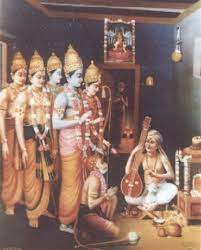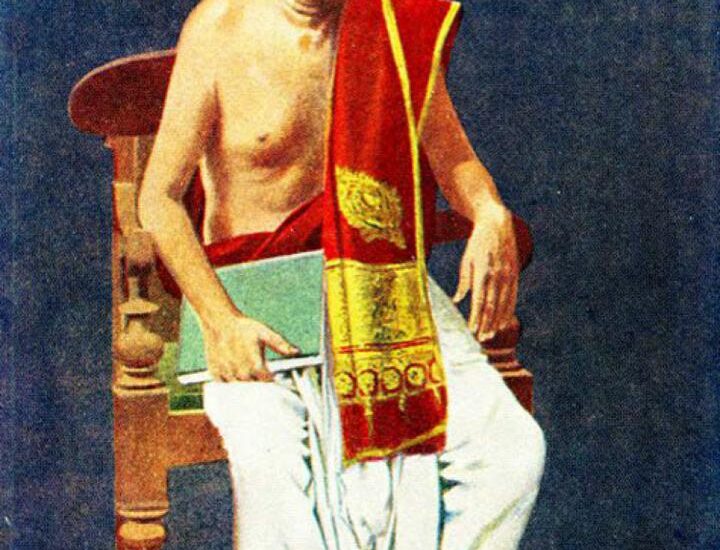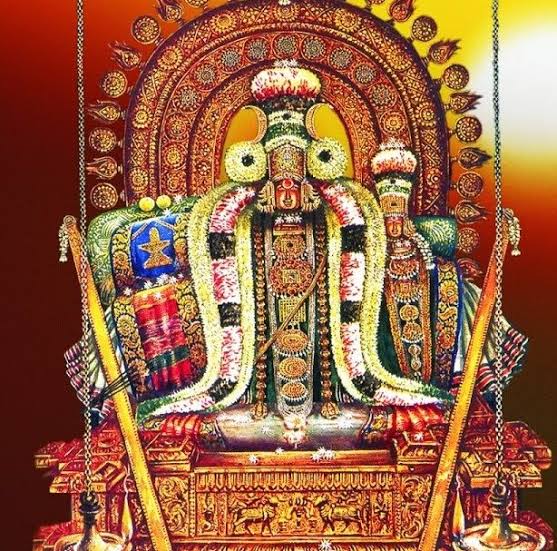Apurva raga-s handled by Tyagaraja Svamigal – Phalaranjani
Dr Aravindh T Ranganathan
This article was published in “Sruti” May, 2019 issue.
Śrī nārasiṃha māṃ pāhi is one of the very few kṛti-s of Tyāgarāja Svāmi on Lord Narasiṃha. It can be considered as a generic kṛti as we don’t see any reference to a particular kṣetraṃ. Earlier texts assign this particular kṛti to a rāgaṃ ‘Phalaranjani’, though we frequently hear this in the rāgaṃ ‘Phalamanjari’. This kind of confusion with respect to rāga nomenclature is very common as Svāmigal himself didn’t reveal the name of these apūrva rāga-s to his disciples (1). Years later, either his disciples or some other musician (s) were instrumental in assigning these rāga names. This topic has been discussed several times in The Music Academy conferences and it is the view of some musicologists that Taccur Siṅgarācāryulu was the musician involved and he named these rāga-s by referring to a treatise, namely Saṅgraha Chūḍamaṇi, whose authorship is unknown (2). Analysis of the available evidences reveals several inconsistencies with respect to the rāgaṃ of this kṛti and its lakṣaṇa. This article will be analyzing the musical aspects of this kṛti addressing the above said issue in the light of Vālājāpet notations.
Vālājāpet notations
Vālājāpet manuscripts form an important source to understand the kṛti-s of Saint Tyāgarājā. These manuscripts were written by Vālājāpet Vēṅkaṭaramaṇa Bhāgavatar (VVB) and his son Vālājāpet Kṛṣṇasvāmy Bhāgavatar (VKB). It is even said Tyāgarājā could have seen this as they were recorded during his life time.(3) These notations were preserved at Madurai Sourāṣtra Sabha and the transcripts are available in GOML, Chennai. Few of these transcripts can be accessed online here (4). These transcripts are the main source for this article. In the absence of first hand records made by Tyāgarājā, these notations form a very valuable and authentic source to understand the version learnt by his prime disciple Vēṅkaṭaramaṇa Bhāgavatar and his son. These notations when used appropriately help us to solve many problems seen with the apūrva kṛti-s of the Saint.
‘Srī nārasiṃha māṃ pāhi’ in earlier texts
It is not a common kṛti to be seen in the earlier texts published between late 1800 and early 1900; it is even rarer to see this kṛti in notation. For the first time we see this kṛti in the text Saṅgīta Sarvārtha Sāra Saṅgrahamu by Vīṇā Rāmanuja (5). Here, it is mentioned as Phalamanjari, but notations or the lakṣaṇaṃ of the rāgaṃ is not provided. It serves no purpose to our study other than to know that this kṛti was in circulation even during 1857. The contents published in this book, especially those of Tyāgarāja kṛti-s in partial or complete can be seen in several texts published later like the texts published by Rāmanujadāsā (1895), Thangavēlu Mudaliyār (1905) et al. Whether they are exact reproductions of the earlier text or they are reproduced from different sources is not known. All these texts too are blinded towards rāga lakṣaṇaṃ of Phalamanjari. So, Phalamanjari mentioned by them is the same as Phalamanjari mentioned in various lakṣaṇa granthā-s or it is a different one is unfathomable.
AM Chinnaswāmy Mudaliyār in his text ‘Oriental Music in European Notation’ (1893) mention the rāga of this kṛti as Phalaranjani for the first time placing it under the mēla 28, Harikāmbhoji (6). It is to be remembered that the main resource person for this text was Vālājāpet Kṛṣṇasvāmy Bhāgavathar, though it was further approved by some other disciples of Tyāgarāja Svāmi. Same information can also be seen in the book published by Tillaisthānaṃ Narasiṃha Bhāgavatar in 1908 (7) and by SA Rāmasvāmy Ayyar (8) under the pseudonym Rāmānanda Yogi in 1910. None of them give us the notations.
Taccur brothers, for the first time gives this kṛti in notation in their book published in the year 1912. They consider it as Phalamanjari and place it under the mēla 22. (9)
From
the above discussion it is clear that this kṛti was not a popular one and not every
musician was aware of this. Sources from Vālājāpet and Tillaisthānaṃ disciple
lineage consider this as Phalaranjani, placing it under the mēla 28. Taccur
brothers and other texts, whose source of this kṛti is unknown, placed it under
the mēla 22. Also, only the book by Taccur brothers gives us this kṛti in
notation.
Rāga lakṣaṇaṃ
Phalaranjani
Before proceeding further, lakṣaṇaṃ of Phalaranjani and Phalamanjari are discussed for getting a better understanding of this kṛti.
Phalamanjari cannot be seen in any of the lakṣaṇa grantha-s available. For the first time, it can be seen in ‘Oriental Music in European Notation’. Vālājāpet manuscripts too mention this name. Knowing the association between VKB and Chinnaswāmy Mudaliyār and the truth that Svāmi didn’t reveal the name of these apūrva rāga-s , it can be speculated that a musician known to Vālājāpet disciple or Vālājāpet disciple like VVB or VKB themselves might have named this rāgaṃ. This was then followed by Tillaisthānaṃ disciples too. Alternatively, a revered disciple of Tyāgarājā could have named this. The scale as deduced from Vālājāpet version (from Vālājāpet notations) is SGMPMDS SNDPMGMRS.
Rāga pravāhaṃ (10) mentions about this rāgaṃ. Scale given here is same as mentioned above; but it is placed under the mela 22. Usually, this text mentions the source from which a particular rāgaṃ was taken. For example, when mentioning the rāgaṃ Phalamanjari, it gives three entries and gives the source for these three entries namely Palaiyāzhi (two entries) and Sangīta Svara Prastāra Sāgaramu of Nāthamuni Panditar. Strangely, in the case of Phalaranjani, no such reference is given. Perhaps, the scale in which this kṛti is sung now is given for the sake of completion. Another Phalaranjani is given under mēla 28 with a different scale – SGPDS SNDPMGMRS ; again source for this scale is not given.
Phalamanjari
Phalamanjari is mentioned as a janya of mēla 15 by Śahāji and Tulajā. Saṅgraha Chūḍamaṇi and its allied texts consider this as a janya of mēla 22, Kharaharapriya. Scale of this rāgaṃ, and considering this as a janya of mēla 22 is uniform across the texts – SGMDS SNDPMGMRS. It is not SGMPMDS in the ārōhaṇaṃ. This rāgaṃ can be seen invariably in any text that acts as a lexicon for these synthetic scales. Many varieties of Phalamanjari seem to exist and they are not discussed here as they do not come under the scope of this paper.
Notated versions of ‘Srī nārasiṃha māṃ pāhi’
Version by Taccur brothers
As said earlier, text by Taccur brothers is the single early text to give this kṛti in notation. Scale given by them is SGMDS SNDPMGMRS. Interestingly, a phrase SRGGRS is seen which cannot be fit into the given ārohaṇaṃ-avarōhaṇaṃ. Usually, kṛti-s in rāga-s like this follows the scale exactly. This raises a doubt regarding the rāgaṃ of this kṛti. Taccur brothers not acknowledging the musician who gave this version is to be remembered here.
It is a must to validate the rāgaṃ given in early texts like the books by Taccur brothers, Sangīta Sarvārtha Sāra Saṅgrahamu and its like as extreme discordance with the rāga name and the commonly accepted lakṣaṇa can be seen. For instance, Taccur brothers mention the ragaṃ of the kṛti ‘sattaleni dinamu’ of Tyāgarāja Svāmi as Jayantasenā. But an analysis of the notation provided rule out the mentioned rāgaṃ, as ṛṣabhaṃ is seen throughout the krithi and Jayantasenā, being a ṛṣabha vaṛjya rāgaṃ cannot fit in (11).Though their immense service is to be acknowledged, only notated compositions are to be considered for research and those too only after a scrutiny is emphasized. All these facts raise suspicion regarding the rāgaṃ of this kṛti.
Tillaisthānaṃ version
Pārthasāradhi has given this kṛti in notation in a book published by him. He has learnt from Dr Srīnivāsa Rāghavan, a descendant of Tillaisthānaṃ Rāma Ayyaṅgār, a disciple of Tyāgarāja Svāmi (12). He mentions as Phalaranjani, a janya of mēla 28 and gives the scale as SGMDS SNDPMGMRS. Here too, phrases like MPM,DNP and GRGM are found which don’t fit into the given scale.
‘Srī nārasiṃha māṃ pāhi’ in unpublished manuscripts
Much valuable information can be obtained by analyzing these unpublished manuscripts existing as a private collection. Inference obtained from few of these is provided here.
Vālājāpet notations
Importance of these notations is already mentioned. These notations, though mention the rāgaṃ of this kṛti as Phalaranjani, did not give information about the mēla (of this rāgaṃ) or its scale. Scale can be easily deduced from the notation provided. For mēla assignation, book by Chinnaswāmy Mudaliyār is followed as the resource person is same (belongs to Vālājāpet lineage).
Version given here adhere exactly to the scale SGMPMDS SNDPMGMRS. Phrases outside this scale can never be seen. The saṅgati-s are organized in such a way that the rāga structure is easily grasped. This is set to the tālaṃ dēśādhi.
First two saṅgati-s clearly gives us an idea about the lakṣaṇa of this rāgaṃ and the same continues throughout the kṛti without creating any ambiguity. Gandaram, pañcamaṃ and dhaivathaṃ were used as gṛha svaraṃ-s and lot of pratyāgata phrases like NDD,DPP, PMM and RSS can be seen thoughout the kṛti. Vālājāpet version can be heard here.
Manuscript of SA Rāmasvāmy Ayyar
SA Rāmasvāmy Ayyar is a disciple of both Vālājāpet Kṛṣṇasvāmy Bhāgavathar and Umayāḷpuraṃ Kṛṣṇa and Sundara Bhāgavathar. Both were the direct disciples of Tyāgarāja Svāmi and he was a fortunate disciple to represent both these schools. He has notated (11) this kṛti and it is exactly in line with the Vālājāpet notations with respect to rāga lakṣaṇaṃ and basic structure of the kṛti. He has published a book (text only) wherein he clearly mentions the rāgaṃ and tālaṃ of this kṛti (see above discussion). To identify the source from which he learnt this kṛti (Vālājāpet or Umayāḷpuraṃ), sāhityam may be taken as a guide. Whereas Vālājāpet version (and the version by Tillaisthānaṃ Narasiṃha Bhāgavatar) reads the first line in anupallavi as ‘dīnārthi nivāraṇa bhavya guṇā’ , Umayāḷpuraṃ version (and the version by Taccur brothers) read as ‘dīnārthi bhaya hara bhavya guṇā’. It can be surmised that his source for this kṛti was from a Valajapet disciple. Additionally this also authenticates Vālājāpet notations.
Umayāḷpuraṃ version
Umayāḷpuraṃ version too consider this as a janya of mēla 28. Scale is not given though we can redact it as SGMPDPMDS SNDPMGMRS. Here too, Gandaram, pañcamaṃ and dhaivathaṃ were used as gṛha svaraṃ-s and lot of pratyāgata phrases like NDD,DPP, PMM and RSS can be seen thoughout the kṛti (13). Basic outline is much in line with Vālājāpet version. Main point of difference between this and Vālājāpet version is the phrase PDP which occurs only once. Whether it is to be considered as a time related change or not is a point to ponder.
Manuscript in the possession Srīvañchiyaṃ Rāmachandra Ayyar
A manuscript of unknown authorship in the possession of Srīvañchiyaṃ Rāmachandra Ayyar mentions the rāgaṃ of this kṛti as Pratāpacintāmaṇi, a janya of mēla 28. No inference can be made as the manuscript lack notation.
Comparison between Vālājāpet notations and the version by Taccur brothers
If we replace the sādhāraṇa gāndhāraṃ with antara gāndhāraṃ (making it as a janya of mēla 28), version by Taccur brothers resemble Vālājāpet version in the basic structure excluding the phrase SRGGRS. This makes one to hypothesize – was the kṛti sung only as a janyaṃ of mela 28 and Taccur brothers changed that to mēla 22 as Phalaranjani was totally unknown to them and earlier texts like Saṅgīta Sarvārtha Sāra Saṅgrahamu, which they followed say it as Phalamanjari ?
‘Srī nārasiṃha māṃ pāhi’ in oral tradition
Very few recordings of this kṛti are available in the public domain. All except one were labeled as Phalamanjari and consider it as a janyaṃ of mēla 22. The recordings adhere to the scale SGMPMDS SNDPMGMRS. Frequency of hearing the phrase of MPM varies with the rendition. In one rendition the phrase GMDNSNDMGMRS is also found. A version considering Phalaranjani as a janya of mēla 22 can be heard here.
Version by Sangīta Kalānidhi Smt R Vēdavalli is labeled as Phalaranjani and considered as a janyaṃ of mēla 28. That too, adheres to the mentioned scale of Phalaranjani, but different from the Vālājāpet version with some additional phrases like DNP.
Conclusion
The following conclusions can be drawn from the above discussion:
1. Vālājāpet notations were the first one to use the name Phalaranjani and there is extreme adherence to the scale.
2. Almost all the earlier texts give the name Phalaranjani and consider this as a janyaṃ of mēla 28. Only Taccur brothers consider this as Phalamanjari, considering it as a janyaṃ of mēla 22. Were they influenced by the texts like Sangīta Sarvārtha Sāra Saṅgrahamu, as they were the editors of the later editions of the mentioned text is to be considered.
3. Vālājāpet version, an existing old version was passed on to next generation as evidenced by analyzing unpublished manuscripts. Identical basic structure of this kṛti seen in Vālājāpet notations, version by SA Rāmasvāmy Ayyar and Umayāṃpuraṃ version can be remembered here denoting the validity of the basic musical structure seen in the Vālājāpet notations.
4. Whereas Phalaranjani version (janya of mēla 28) is commonly associated with this kṛti in textual tradition, Phalamanjari (janya of mēla 22) version is commonly associated with this kṛti in oral tradition.
5. This article highlights the importance of analyzing Vālājāpet versions and other unpublished manuscripts.
Acknowledgements
I thank Srivanchiyam Sri Chandrasekar, son of Srivanchiyam Sri Ramachandra Ayyar for sharing the rare manuscripts collected and preserved by his father.
I thank Ms Janaki, Editor, Sruti Magazine for publishing this musicological work.
The library in The Music Academy is a repository of many valuable manuscripts written in the early part of the last century, like that of S A Ramaswamy Ayyar. I thank Sri V Sriram, Secretary, The Music Academy for permitting me to access those valuable manuscripts.
References
- Subbarāma Dīkṣitulu. Prathamābhyāsa Pustakamu, Pg 129. Vidyā Vilāsini Press, Eṭṭayapuraṃ Subbarāma Samasthānaṃ, 1905.
- Ramachandran K.V. (1938) – “The Melakarta – A Critique” – The Journal of the Music Academy 1938 volume IX: pg 31-33.
- Sāmbamurti P. The Walajapet manuscripts. Journal of Music Academy 1947: Pg 114-129.
- Vālājāpet manuscripts. http://musicresearchlibrary.net/omeka/items/browse?collection=1&sort_field=Dublin+Core%2CTitle&page=12
- Vīṇā Rāmānujayya. Saṅgīta Sarvārta Sāra Saṅgrahamu, Pg. 231. http://musicresearchlibrary.net/omeka/items/show/666
- Chinnasvāmy Mudaliyār. Oriental Music in European Notation, pg 75. Ave Maria Press, Madras,1893. http://musicresearchlibrary.net/omeka/items/show/507
- Ghṛtasthānaṃ Narasimha Bhāgavatar., ed.,Tyāgarājasvāmi Kīrtanalu , Pg 13; Sarasvathi Power Press, Rajahmundry, 1908.
- Rāmānanda Yōgi., ed., Tyāgarājasvāmi Kīrtanaṅgaḷ, Pg 120 . Kṛṣṇasvāmy and Sons, 1910.
- Taccur Śingarācāryulu, Cinna Śankarācāryulu . Gānenduśekharaṃ, Pg 57-61. Kalā Ratnākara, Mudrākśara Śālā, Cennapuri, 1912
- Dr MN Dhandapāṇi, D Pattaṃṃāḷ. Rāga Pravāhaṃ. The Trinity Music Book Publishers, Chennai, 1984.
- Taccur Śingarācāryulu, Cinna Śankarācāryulu . Gāyaka Siddhāñjanaṃ, Pg 69-70. http://www.ibiblio.org/guruguha/MusicResearchLibrary/Books-Tel/BkTe-TaccuruBros-gAyaka-siddhAnjanam-Pt2-1905-Xrx-0084.pdf
- Pārthasāradhi, S., ed., Śri Tyāgarājasvāmi Kīrtanaigaḷ – Tillaisthānaṃ pāṭaṃ – part 1, Pg 6-9. Guru Sri Tyāgabrahma Ārādana Kainkaryaṃ, 1987.
- Manuscripts given by Vidvān Sri B Kṛṣṇamūrti, the versions he learnt from Umayāḷpuraṃ Sri Rājagōpāla Ayyar – http://musicresearchlibrary.net/omeka/files/original/83b9276a2529b0a8e26bf08c4cb7ba7e.pdf



What is your view on the version played by Ranganayaki.
https://www.youtube.com/watch?v=-GGDZJqF4jg
It is same as the common version considering Phalaranjani as a janya of mela 22.